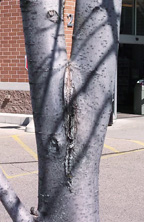Are trees that have one central leader better than multi-trunked forms?
EXCURRENT - In arboriculture, a tree that has a straight trunk from ground level to the very tip.
Many trees and arborescent shrubs (tree-like shrubs) are selected for this very excurrent growth structure. In some trees, this seems to be a human idealized form. All types of trees are prone to co-dominate leaders. (see picture)
While these idealized forms may remain throughout a tree’s life, they often develop co-dominate leaders. This may be two or more vertically growing leaders, ‘vying for leadership’.
These co-dominate leaders may prove to be disastrous, as they develop bark inclusions between themselves. As the diameter of each co-dominate leader continues to grow, the space between them grows narrower and narrower until they are pushing against each other with everything they got.
This force gets so strong, it pushes the bark tissue out from the sides of their junctions. As pressure continues to increase, it sometimes leads to the fracturing of the connecting woody tissues. The tree is damaging itself!
These pressures along with torquing gusty winds often causes one or more of the co-dominate limbs to break away, leaving a gaping hole, shattered wood and a long tear in the bark below the break.
When removed, damage to the regenerative collar is found to be totally compromised, leaving the remaining portion of the tree unbalanced and without hope of compartmentalizating the wound.
It’s very important to annually assess all of your trees to make sure they don’t develop co-dominate leaders. If found, one of the leaders will need to be removed. Usually it is best to remove the leader that is not growing the straightest or that may grow into the best form. Regretfully, sometimes this may be the tallest leader.



